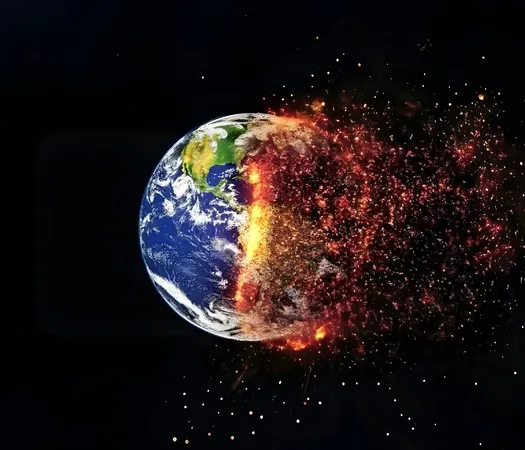
The Rising Costs of Climate Change: Why We Must Act Before It's Too Late
2024-12-02
Author: Rajesh
The Rising Costs of Climate Change: Why We Must Act Before It's Too Late
A monumental shift often occurs in Earth’s climate system when we hit what scientists refer to as a "tipping point." Think of it as a series of dominoes — when the first domino falls, it triggers a cascade of events that can result in not only accelerated warming but also higher sea levels and increasingly severe weather patterns.
While many have focused on the environmental implications of crossing these tipping points, a groundbreaking new study highlights a critical yet under-discussed issue — the skyrocketing financial and logistical costs of reversing the damage.
Published in **npj Climate and Atmospheric Science**, the research reveals that once we cross certain climate thresholds, the cost of rectifying the resulting damage can multiply exponentially. For instance, the effort to restore melted polar sea ice can become nearly four times as expensive if we wait until after the tipping point has been crossed compared to taking preventive measures beforehand. This stark revelation is one of the first times researchers have quantified the significant economic ramifications of pre- and post-threshold interventions.
Dangers of Climate Tipping Points
Climate tipping points are essential thresholds in Earth’s systems. Once breached, they can lead to severe and often irreversible damage. Classic cases include the melting of polar ice sheets, the widespread die-off of tropical coral reefs, and the collapse of entire ecosystems — consequences that can result in devastating coastal flooding, rampant biodiversity loss, and chaotic weather patterns.
The Cost of Inaction
New questions arise: How much effort and investment would it require to halt damage before a tipping point? How much worse would these costs become once we have crossed that line? The urgency of these questions cannot be understated.
Restoring polar sea ice is a complex undertaking that necessitates not only halting the current melting process but also re-establishing ice cover. According to the lead author, mathematician Parvathi Kooloth, delaying intervention comes with severe consequences.
"You either shoulder the cost now, just before the threshold is crossed, or you wait," Kooloth emphasizes. "If you wait, the degree of intervention needed to revert climate systems rises drastically. Corrective actions taken after the fact are far more expensive and complex than preventive ones."
Understanding Tipping Points
Each climate tipping point is a unique entity shaped by various factors, such as ocean heat transport and cloud cover. These elements influence the trajectory of changes following a tipping point, shaping intervention strategies. Interestingly, researchers have discovered a universal equation that describes the fundamental nature of these tipping points, enabling them to study shared behaviors and offering potential early warning systems for impending crises.
The Overshoot Window: A Short Opportunity for Change
The research also discusses a concept known as the “overshoot window,” a temporary phase just after a tipping point is crossed when the costs of intervention may only rise gradually. This window allows for a brief opportunity to mitigate damage as some environmental systems may take longer to react dramatically. However, this opportunity is a double-edged sword — the longer we delay, the steeper the costs will eventually become.
"This is no free lunch," Kooloth warns. "The extra time we gain comes with an even steeper increase in intervention costs once we fully cross that overshoot window."
The Irreversible Effects of Climate Change
Not all consequences following the crossing of tipping points can be undone. Ecosystems lost to prolonged environmental shifts may never recover fully, and some changes could be so significant they require more effort to reverse than the original actions that caused them. Kooloth notes the unnerving reality: "The paths forward and backward are often not the same."
Imagine if, by the end of the century, we were to see a complete melting of Arctic sea ice due to high emissions. Simply dialling emissions back to current levels in 2024 may not suffice to restore those ice caps. Instead, we might need to reduce emissions to levels that predate our current scenario — a sobering thought that must guide our future actions.
The Case for Proactive Measures
This compelling study underscores the urgent necessity for proactive measures against climate tipping points. Delaying action is not only detrimental to the environment but also significantly exacerbates costs and challenges associated with intervention.
By mobilizing now, global leaders and policymakers can help mitigate the long-term economic repercussions of climate change and prevent our planet from entering a phase of irreversible degradation. The time for decisive action is now — before it’s too late.
Let this be a wake-up call to our responsibility! The future depends on the choices we make today.



 Brasil (PT)
Brasil (PT)
 Canada (EN)
Canada (EN)
 Chile (ES)
Chile (ES)
 España (ES)
España (ES)
 France (FR)
France (FR)
 Hong Kong (EN)
Hong Kong (EN)
 Italia (IT)
Italia (IT)
 日本 (JA)
日本 (JA)
 Magyarország (HU)
Magyarország (HU)
 Norge (NO)
Norge (NO)
 Polska (PL)
Polska (PL)
 Schweiz (DE)
Schweiz (DE)
 Singapore (EN)
Singapore (EN)
 Sverige (SV)
Sverige (SV)
 Suomi (FI)
Suomi (FI)
 Türkiye (TR)
Türkiye (TR)